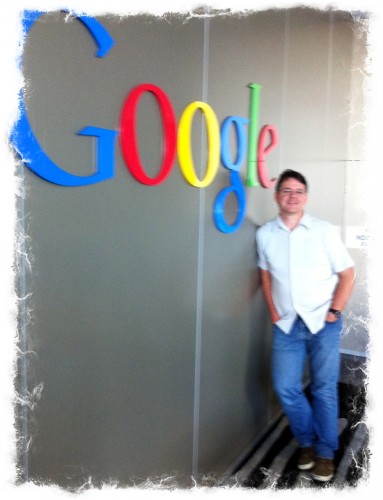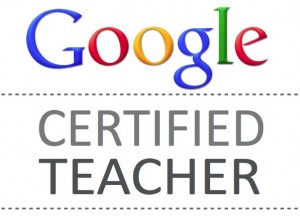What do you think of when you hear the name Google? To many people, it’s just the place to go when they want to find something on the web. You just type a few words into that simple text box and, hey presto, you usually find what you’re after. To the majority of users on the web, that’s just what Google does.
If you’re a serious web user, you know they do a little more than that.
 Last week, along with 53 other amazing educators from around the world, I had the pleasure of attending the Google Teacher Academy in Sydney. It was the tenth GTA since the program started, but only the second to be held outside the USA. There was a selection process to be part of it, and many more applied than were actually accepted. There was a ton of hype and excitement leading up to it, with Twitter carrying the anticipation of both those who would be attending as well as those who wished they were. So what was it like?
Last week, along with 53 other amazing educators from around the world, I had the pleasure of attending the Google Teacher Academy in Sydney. It was the tenth GTA since the program started, but only the second to be held outside the USA. There was a selection process to be part of it, and many more applied than were actually accepted. There was a ton of hype and excitement leading up to it, with Twitter carrying the anticipation of both those who would be attending as well as those who wished they were. So what was it like?
I wasn’t exactly sure what to expect from the GTA. I knew it would be a fast paced brain dump of information about Google tools. I suspected we would get some inside information about where Google was heading in the education sector. I hoped to hear from others about innovative ways that they were using Google’s cloud based services in their schools. I expected to be able to play with devices and tools I hadn’t used before. I hoped to to see a little bit about life in the Aussie Googleplex. I was looking forward to connecting in real life with many of the names and faces that were part of my online community, as well as meeting many new people. And of course I had great expectations for the networking and socialising that would take place amongst those lucky enough to be chosen to attend.
On all of these fronts my expectations were met and exceeded.
The information we received prior to the event suggested that it would be a fast paced tour of everything Google, and it certainly was that. From the start of the day we had ideas, suggestions, tips and examples thrown at us almost faster than we could absorb them. Thankfully someone started a collaborative Doc that we all took notes into, and together we managed to document much of it. We were given a fast paced tour through the full range of information search tools that Google offers – regular search, images, squared, maps, books, scholar, wonderwheel, realtime, alerts, news, custom search, recipes, readability, creative commons… the list of search variations and extensions that Google now offers is quite amazing. To be honest, there was not a lot in the list that I hadn’t seen before, but it was good to be reminded of the depth of search options that Google offers and to see just how far some of them have come since I last looked at them. Book Search and Scholar Search in particular have come a long way since I last used them.
The barrage of information continued through the use of Gmail, Calendar, Apps and Sites. Although I use all of these tools, most fairly regularly, it was useful to learn some new power user tips and to realise just how far some of them can be pushed beyond the way I currently use them. And as funny as it seemed to hear Danny Silva talking about “making Google Calendar sexy”, it was really useful to learn about that aspect of the Google toolbox. So useful in fact that I came home and completely reorganised my own use of calendaring, dropping Apple’s iCal and moving my whole online life to Google Calendar instead. That might be the subject of a whole other blogpost sometime, as I think I’ve finally hit on a usable cloud/mobile solution that works for me, that doesn’t require Apple’s outrageously expensive MobileMe service.
We spent a good deal of time looking at Google Apps for Education (GAFE), something I found really useful since my school uses them more and more, and as the year progresses I can see that use will increase exponentially. We looked at Sites in some detail, which was interesting because I’ve never really thought of Sites as being a wiki product although it’s now pretty obvious that that’s what it is. Again, as we ramp up our use of GAFE, the Sites component will begin to play an increasingly important part of the toolset we offer our students. Potentially, the use of Sites, Apps, Gmail and Calendar could cause us to dramatically rethink the current tools we offer to our students. All free, all managed by Google. Pretty amazing really.
We looked at some lesser known tools like Hapara, had a GTalk video call with Mike Lawrence from CUE in the US, and also heard from one the project heads of the Blogger and Google Apps team. There are some fantastic things coming for Blogger users, enough to make me seriously question my continued use of WordPress. A lot of this discussion was under NDA so I can’t elaborate on it, but the demos and examples we were shown really blew me away. If this is what HTML5 will do to the web, we’re in for some interesting times ahead!
Towards the end of the day we had a talk from the project lead of Mobile, who brought in a bunch of Android devices for us to play with, including the as-yet-unreleased-in-Australia Motorola Xoom tablet. I have to say I was very impressed with what Android offers, and enjoyed being able to play with these gadgets.
Speaking of gadgets, one of the nice surprises we got as we entered the room was a Cr-48 Chrome laptop to play with. Unfortunately we had to give them back at the end of the day, but I’d been keen to try the Chrome OS so getting a Cr-48 to use was much appreciated. Unfortunately, we were having a bit of trouble with the wifi (dodgy wifi at Google of all places! This was one place where I expected Internet access to be kick-ass!) so the Cr-48 struggled to really impress me. Being a completely cloud-based experience – the OS is essentially just a Chrome web browser – the flaky wifi made for a disappointing Cr-48 experience. I like the concept of a machine that is entirely cloud based. Flash memory means it boots in seconds and you log in with your Google account then basically just live in the browser. I liked the way that the Chrome OS automatically synced with my Chrome settings from my other computers, adding all my favourite extensions and remembering all my settings. Overall, I found the Cr-48 a little frustrating. While I can see a network-based machine would work for certain use cases, I think I’d find it far too limiting as my only computing device. Despite the fact that I had been really looking forward to trying the Cr-48, by mid morning I’d resorted back to my MacBook Pro (where, ironically, I still spent almost 100% of the rest of my day using nothing but Chrome Browser!)
Just before lunch we were given a tour through the Googleplex to see the fabled work environment at Google. Unfortunately photography wasn’t allowed in the building so I have no pictures to show, but I found it interesting that so much thought was given to the architecture of creating a whimsical, playful and personal space for people to work in. As well as the actual “work areas” of desks, computers and monitors, there were many hidden spaces for people to use to relax, chill out, get some private time, meet in small teams, think, meditate, and so on. From small little cubby holes where Googlers could lock themselves away to work in silence, to meeting places that looked like something out of a movie set, to whole rooms populated by indoor gardens and playful decor, there was something for everyone. It was not unusual to find quiet corners with large TV screens, couches and game consoles, to sleep tanks, to pool tables and foosball games. Unlike teachers, whose lives tend to be ruled by bells that ring every 55 minutes, it was good to see that people in the real world are free to manage themselves, work hard but find time to play, and be trusted to produce. It was good to see that Google’s famous “20% time” is alive and well here in the Sydney office.
The Googleplex struck me as a particularly pleasant working environment, where the workers were given both resources and trust to use them responsibly. I couldn’t help but imagine the same environment being used in a school, where students had their own places to work and meet and talk and play and produce. I’d love to see a school using this same architectural model of open space and interesting interior design, of playfulness and whimsy, of trust and productivity. It made me further realise what an enormous impact the physical design of a space can have on the learning/working environment. The closest I’ve seen in education have been the Discovery and Unlimited schools in Christchurch, but providing a more Google-like environment for more schools would be a very interesting experiment.
We got to hear “Inspiring Ideas” from six teacher participants who were selected in advance to give a 5 minute presentation of some innovative ways they have been using Google tools with their students. I was lucky enough to be one of the six presenters, and although 5 minutes is not a long time to fully present an idea, it was fun to share something with the group and interesting to see what others have been up to.
Of course, the people were the real magic of the day. Although it was useful to experience the firehose of Google tools, there really wasn’t very much that I hadn’t seen before. Certainly spending time looking more closely at the tools was useful, but you could argue that a motivated person could learn all these things simply by playing with them and watching some YouTube how-to videos. Although the tools consumed a large part of the day, the real value was in connecting with some amazing teachers. Some of the best parts of the day were in the small group sessions, and especially during the optional half-day unconference session on Thursday, where we got to spend a little more time actually talking and sharing with each other. It was great to put faces to names, to meet people I’d only ever known online, and to meet new people I never knew before. The official dinner on Wednesday night, as well as the unofficial dinner I organised at BlackBird Cafe on Thursday night, was a great way to get to know the other participants, and I suspect that many future collaborations will emerge as a result of this whole event.
On the whole, it was a great experience, learning more about powerful tools we all use every day, seeing a bit of vision for how organisations can work, and connecting with other innovative and inspiring educators. Several people have asked me “was it worth it”, and my answer is definitely “yes!”
But that’s not to say it was perfect either. There were things I’d change about it if I had the power. The main one is that one day is simply not long enough. The teachers who were accepted into the GTA were all very intelligent individuals with a demonstrated ability to learn and use these tools, so they were able to keep up with the fast pace. But I can’t help thinking how much more powerful the event would have been if we were given more time to unpack these tools more fully into our own educational contexts, to really think through what they can do for us and to share ideas for how to best leverage them. I mentioned this to the organisers and while they agreed in principal, their thinking was that we can go away after the event to do that. To some extent I see that as being a little back-to-front… we can learn more about the tools anytime, but we are only face-to-face with this group for a very short time. The better solution would be to have a longer event. Apple’s ADE Institute goes for 4 whole days and gets the participants sharing and collaborating on CBL projects together. Adobe’s AEL Summer Institute goes for 5 days and participants work together and learn from each other over that time. Our biggest complaint about schools is a crowded curriculum that doesn’t allow enough time for reflection and play. The GTA suffered the same problem.
One day for GTA is simply not long enough, and doesn’t do the program justice. Especially with it being held here in Sydney, with so many people traveling such a long way to get here, it seems a shame to have it all wrapped up in a day and half. I realise that there are budget constraints to these programs, but to really get value from them requires some time to take it in, think about it, ask questions, put ideas into action. Just like working at Google itself, the GTA would benefit from some 20% time.
Remember, the actual GTA is just one day. The extra half day unconference – which many people commented was the most valuable part – is optional, and wasn’t funded by Google. It was done voluntarily by the organising team (thank you!)
The problem with having to pack so much into such a short time is that it puts way more focus on the actual tools themselves, rather than the pedagogical uses of what can be done with the tools. A few people I met had a quiet grumble about the very tool-driven nature of the GTA, seeing it as being counter to what we say is important in education. Smart teachers have a mantra of “It’s not about the tools”, and yet we spent a full day focusing almost solely on the tools. This is not to suggest that all the tool talk wasn’t useful – it certainly was – but the short timeframe forced us into putting a lot of emphasis on the tools and not nearly enough on the pedagogy, and that’s unfortunate.
I also wanted to comment about the physical environment of the room we worked in. Again, I know there are always constraints when working in someone else’s space, but I was surprised to find the room set up with rows of tables all facing the front. Especially because there were parts of the day when we were working in teams, having the rooms set up like a traditional classroom with rows of desks and an obvious “front of the room” where people could deliver content, seemed counterproductive to the goals we say matter to us. If “21st century learning” is about teams and collaboration and discussion and flexibility, then it would have been good to be working in an environment that facilitated that more effectively. Putting desks in islands where teams could face each other, and physically creating a learning environment that represented the pedagogy we say is important would have been better. That might sound like I’m being overly critical, but if we can’t model these things at this kind of event, then where can we model it?
 Overall, I very glad I was able to be part of the Sydney GTA. It was a great chance to be part of something special, and to join a global team of Google Certified Teachers who stay in regular contact online. It was great to meet people from all over the place, and to realise that no matter where we teach, we have a lot in common.
Overall, I very glad I was able to be part of the Sydney GTA. It was a great chance to be part of something special, and to join a global team of Google Certified Teachers who stay in regular contact online. It was great to meet people from all over the place, and to realise that no matter where we teach, we have a lot in common.
Special thanks to the GTA team of Mark Wagner, Lisa Thumann, Wendy Gorton, Danny Silva, Kern Kelley and Dana Nguyen. It was really good to meet you all, and I even got the chance to go hiking in the Blue Mountains with Mark, Lisa and Wendy before they headed back home.
I’m looking forward to doing some great stuff with all of this information and working with other GCTs over the coming years.
 This post is a bit of a call for assistance from any schools in Indonesia. If you could assist we would really appreciate it.
This post is a bit of a call for assistance from any schools in Indonesia. If you could assist we would really appreciate it.

 Overall, I very glad I was able to be part of the Sydney GTA. It was a great chance to be part of something special, and to join a global team of
Overall, I very glad I was able to be part of the Sydney GTA. It was a great chance to be part of something special, and to join a global team of